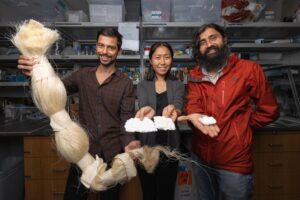
La pobreza menstrual afecta a millones de mujeres en el mundo, lo que significa que no tengan acceso a productos femeninos de higiene como toallas sanitarias, tampones o copas menstruales, situación que investigadores de Stanford quieren cambiar, al crear toallas sanitarias a base de plantas que reducirían su costo y con ello mejorar su acceso.
Y es que, investigadores de Stanford han diseñado un proceso de código abierto para convertir fibras de sisal (fibras de las hojas de algunos agaves, plata originaria de México) en material absorbente para toallas sanitarias menstruales, creando una oportunidad para la fabricación local y sostenible de estos productos de higiene que muchas comunidades necesitan.
Para las personas menstruantes, el acceso a productos menstruales asequibles e higiénicos es una necesidad. Estudios estiman que 500 millones de personas (mujeres, niñas e individuos transgénero y no binarios) no tienen acceso a las instalaciones y productos que necesitan para controlar su período.
Manu Prakash, profesor asociado de bioingeniería en Stanford, y sus colaboradores han desarrollado un método para convertir las fibras de la planta de sisal en un material esponjoso y absorbente para toallas sanitarias menstruales. Y, al ser un proceso de código abierto, podría ayudar a los pequeños fabricantes a utilizar materiales de origen local para crear productos menstruales asequibles y de alta calidad para sus comunidades.
“Para abrir el acceso a la fabricación local, hay que pensar de dónde vendrán las materias primas”, señaló Prakash. En Kenia en particular, “resulta que el sisal es absolutamente increíble”.
De acuerdo con el trabajo publicado recientemente en Communications Engineering de Nature, un componente crítico de una toalla sanitaria menstrual es el núcleo absorbente. Para encontrar el mejor material para crear almohadillas a base de plantas, los investigadores comenzaron con un enfoque sistemático, analizando los productos existentes y los recursos biológicos que se utilizan en diferentes áreas del mundo.
Algunos cultivos, como el algodón, precisaron, eran demasiado costosos y requerían mucha agua, y otros, como la madera, sólo tenían grandes suministros disponibles en unos pocos países.
“Comenzamos a mapear todo. Mapeamos plátanos, mapeamos jacintos de agua, todo lo que pudimos conseguir”, dice Prakash. “La idea era crear un mapa de biodiversidad, observando tantas plantas como pudiéramos encontrar y conjuntos de procesos universales que pueden dar lugar a productos de alta absorción”.
Alex Odundu, un ingeniero keniano, también coautor del artículo, ha estado desarrollando maquinaria para ayudar a las pequeñas comunidades agrícolas a procesar el sisal de manera más eficiente. El sisal se ha cultivado en partes de África y otras regiones porque las fibras de sus hojas pueden convertirse en fuertes cuerdas y cordeles.
El equipo sabía que era una planta que requería poco mantenimiento y que prosperaba incluso en años de sequía, pero nadie había intentado utilizarla para producir la pulpa de celulosa de alta calidad necesaria para una toalla sanitaria menstrual.
Inspirándose en la forma en que las termitas descomponen la madera, Prakash y sus colegas desarrollaron un proceso para eliminar la lignina (un polímero de las células vegetales que proporciona estructura y repele el agua) de las fibras de sisal y utilizaron una licuadora para romper las macrofibras de celulosa restantes. en microfibras, lo que da como resultado una pelusa aireada y absorbente.
“El resultado es una hermosa pelusa que parece casi indistinguible del algodón”, dijo Anton Molina, estudiante de doctorado en el laboratorio de Prakash y coautor del artículo. “Las propiedades a microescala de las fibras son las que hacen que el sisal se destaque. Es una mejor alternativa que, digamos, el cáñamo o el lino y supera el rendimiento de los discos de algodón disponibles comercialmente”.
Además, los productos químicos utilizados en el procesamiento son fáciles de conseguir y pueden reciclarse en otros productos o transformarse de forma inofensiva en dióxido de carbono y agua.
“Uno de los aspectos clave de este documento fue garantizar que la cantidad mínima de productos químicos que utilizamos pueda obtenerse y fabricarse in situ”, afirmó Prakash. Actualmente, el equipo está probando enfoques y materiales similares para producir las capas superiores porosas y inferiores impermeables de una plataforma, creando una tubería simple de extremo a extremo para ir desde la planta hasta una plataforma completa.
“Realmente se puede imaginar una fábrica a pequeña escala, tal vez del tamaño de una cervecería local, que produzca de 5 a 10 mil pastillas por día sin nada más que el material biológico que entra y los productos que salen”.
“Hasta ahora ha sido fantástico aprender de otros en todo el mundo”, dice Anesta Kothari, investigadora del laboratorio de Prakash y coautora del artículo. “Estamos tratando de trabajar directamente con las comunidades y hacer que nuestras herramientas lleguen a manos de los usuarios”.
Con ese fin, los investigadores han iniciado el Plant Pad Consortium, un grupo internacional de empresarios, grupos académicos y organizaciones no gubernamentales que quieren construir y compartir el conocimiento necesario para desarrollar soluciones locales, sostenibles y asequibles para la higiene menstrual.
Te puede interesar: Productores orgánicos ven un nuevo papel en la era del cambio climático

